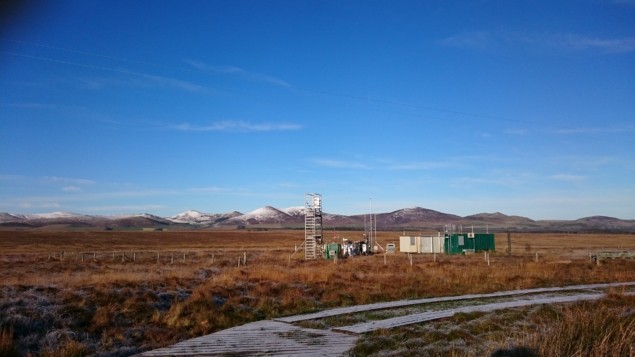Measurements from Scottish peatland could provide knowledge needed to cut emissions harmful to human health, as Kate Ravilious reports

A sea of grass ripples in the wind, whilst occasional clumps of heather stand proud, refusing to bend. In the distance gullies on the Pentland Hills hold the remnants of winter snow. Sheep graze and lapwings sound their distinctive “peewit” call. If it weren’t for the cluster of boxes, tubes and metal rods, you’d be hard pressed to identify that this is the 21st century. But the Auchencorth Moss peatland, around 20 km south of Scottish capital Edinburgh, is very much in the present, and its pristine environment is proving invaluable in pinpointing where air pollution comes from.
The negative health consequences associated with air pollution are on a par with obesity. Essentially it accelerates all age-related health conditions.
Caleb Finch
Knowing more about that air pollution is crucial. From the fug of exhaust fumes in traffic-clogged streets to invisible vapours dispersed by industrial plants and gases released from fertiliser applied to fields, Earth’s atmosphere contains a cocktail of added ingredients. Many of these atmospheric extras turn out to be bad for our health. Scientists are just beginning to unravel the chronic impacts, but the early evidence is worrying. Long-term exposure to poor quality air has been linked to everything from low birthweight babies and teenage misbehaviour to arterial disease, respiratory problems and increased risk of dementia.
“The negative health consequences associated with air pollution are on a par with obesity,” says Caleb Finch of the University of Southern California, US, who studies brain development and ageing. “Essentially it accelerates all age-related health conditions.”
Back on Auchencorth Moss, the bracing breeze makes air pollution seem the last thing worth worrying about. Its distance from belching industrial chimmneys and fume-filled city streets is exactly what makes this peatland valuable, and the odd-looking tubes, boxes and wires are high-tech instruments that monitor the composition of the air each hour.
“The site was chosen due to the lack of sources of anthropogenic pollution in the dominant wind direction,” says Marsailidh Twigg of the Centre for Ecology and Hydrology in Edinburgh. On a good day, the air at Auchencorth is as pristine as the air usually found in rural Scandinavia. But other days may see pollution plumes emanating from continental Europe and the UK. “When we get large pollution events the measurements from Auchencorth help us to separate out what has been transported into our cities and what has been generated within our cities,” says Twigg.
Pollution can travel far, sometimes hitching a ride on a storm, or surfing the breeze to cross an ocean. At Auchencorth during high pollution episodes the winds are often easterly, with a larger than usual fraction of pollutants coming from Western Europe. “Air pollution is not limited by boundaries and transport between countries is driven by meteorology,” says Twigg. “We need to tackle emissions collaboratively across nations since this is a global problem.” Averaged across the year, however, the dominant source of particulate pollution originates from UK emissions.
Spring peaks
There are seasonal changes too. In spring, Auchencorth’s male lapwings display spectacular aerobatics, zigzagging, rolling and diving to impress a mate whilst the hardy sheep have their first lambs. But Twigg and her colleagues have shown that there’s often a peak of pollution, as well as spring, in the air. These spring pollution events result from ammonia – mostly from spreading manure on fields – interacting with nitric acid, typically formed from emissions of nitrogen dioxides by transport in cities. Together, these two chemicals form particles of ammonium nitrate. Under stable atmospheric conditions, such as a “blocking” high pressure system, there’s less mixing to dilute the pollutants. Cool spring temperatures, meanwhile, allow the pollutant to accumulate rather than evaporate. There’s no easy solution.
“Fertilisation of our crops is important, otherwise half the world’s population would not have access to food, but in some countries the current methods and the quantity of fertiliser applied can result in nitrogen escaping into the atmosphere as ammonia gas, rather than being taken up by the plant,” says Twigg.

Away from Auchencorth, it is the inhabitants of large cities who often experience the ill effects associated with air pollution. The cocktail of fumes from idling engines mixed with pollution blown in from further afield creates a particle-laden fug; on still days some cities sit inside their own toxic haze. Jiu-Chiuan Chen, a co-worker of Finch’s at the University of Southern California, lives in one of those large cities – Los Angeles. In recent years he’s researched how air pollution affects our brains.
Chen and colleagues analysed health data gathered during the Women’s Health Initiative Memory Study, which followed a large group of healthy older women from across the US from 1999 to 2010. Using an air quality model, the scientists estimated the particulate pollution where the women lived. Women who were exposed to higher levels of particulate pollution suffered faster rates of cognitive decline and had nearly double the risk of developing dementia, the study showed. “If our results are applicable to the general population, fine particulate pollution in the ambient air may be responsible for about one out of every five cases of dementia,” Chen and Finch wrote in an article for The Conversation.

Concentration of small air pollution particles has risen by more than one-third
Exactly how air pollution enters and harms the brain isn’t yet clear. But experiments show that mice that are genetically predisposed towards Alzheimer’s disease accumulate larger deposits of beta-amyloid proteins on their brains when exposed to particulate matter. “We think that the particles alter membranes in cells, which changes the activity of certain enzymes and ultimately leads to increased production of beta-amyloid proteins,” says Finch, who recently authored a book, The Role of Global Air Pollution in Aging and Disease. In humans these proteins are a major target of therapies to prevent the onset of Alzheimer’s disease.
It’s not just air pollution’s long-term impacts on physical health that should concern us. People with mental and behavioural disorders, according to a study published in Environment International, were significantly more likely to die on days when air pollution was very high. Analysing a decade of statistics, Lin Yang from Hong Kong Polytechnic University and colleagues showed that the mortality risk for people in Hong Kong with pre-existing mental health conditions increased by 16% on the first day of haze and 27% on the second day. If ozone pollution accompanied the haze, the mortality risk rose by a whopping 79%. The precise mechanism behind the link isn’t yet known, but it may be linked to mood. “Haze days are very likely to trigger an acute depression response in people,” Yang told the Guardian. “This has been shown in surveys in 2013 in Indonesia, where there was a big disaster of haze from forest fires.”
There’s clearly a need for action and with determination we can reduce air pollution. The rewards would follow relatively soon, as they have in the past. “In Los Angeles, where I live, there was a local decision to reduce the use of black coal back in the 1970s and since then we have seen the bad-air days decrease by 90%,” says Finch. The Auchencorth measurements also bring some good news, showing a drop in sulphur dioxide concentrations of more than 90% over the course of two decades. “This reflects the more stringent emissions targets,” says Twigg.
But it’s hard for local authorities to know how to act unless they know where the air pollution is coming from, why it’s produced, and what could reduce emissions. Which is where sites like Auchencorth Moss play a role. It would be easy to blame high pollution days in UK cities on traffic jams, but as the data from Auchencorth show, it isn’t that simple. Often pollution events have a combination of causes – traffic pollution, fertilising fields and meteorology. Tackling these complex events requires understanding their roots.
Back at Auchencorth, the lapwings wheel, the grasses bend, and the sheep are unconcerned. In the midst of that rural idyll the tubes and pipes whirr and click, taking a quarter of a million measurements each year. Together with data from similar networks, these measurements will provide the evidence to help the next generation breathe more easily. The answer is blowing in the wind.



